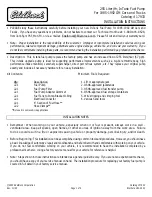
6. Insert the flat side of the new wiper blade
onto the bottom part of the holder. Insert
the blade all the way.
7. Install the end of the wiper blade into the
end cap.
8. Slide the wiper holder onto the wiper arm
securely.
9. Lower the passenger side wiper arm first,
then the driver side.
10. Set the power mode to ON and hold the wiper switch in the MIST positions until
both wiper arms return to the standard position.
Avoid dropping the wiper arm, as it may damage the windshield.
Tire Information
To safely operate your vehicle, your tires must be of the proper type and size, in
good condition with adequate tread, and properly inflated.
n
Inflation Guidelines
• Properly inflated tires provide the best combination of handling, tread life, and
comfort. Refer to the driver’s doorjamb label or the specifications see
SPECIFICATIONS for the specified pressure.
MAINTENANCE
168 |
• Underinflated tires wear unevenly, adversely affect handling and fuel
economy, and are more likely to fail from overheating.
• Overinflated tires make your vehicle ride harshly, are more prone to road
hazards, and wear unevenly.
• Every day before you drive, look at each of the tires. If one looks lower than
the others, check the pressure with a tire gauge.
• Measure the air pressure when tires are cold. This means the vehicle has been
parked for at least 3 hours, or driven less than 1 mile (1.6 km). If necessary, add
or release air until the specified pressure is reached. If checked when hot, tire
pressure can be as much as 4-6 psi (30-40 kPa, 0.3-0.4 kgf/cm
2
) higher than
checked when cold.
• At least once a month or before long trips, use a gauge to measure the
pressure in all tires, including the spare
*1
. Even tires in good condition can lose
1-2 psi (10-20 kPa, 0.1-0.2 kgf/cm
2
) per month.
n
Inspection Guidelines
Every time you inflate the tires, check for the following:
• Any damage to tires, including bumps, bulges, cuts, splits, or cracks in the side
or tread. Remove any foreign objects and inspect for air leaks. Replace tires if
you see fabric or cord.
• Uneven or excessive tread wear. Have a dealer check the wheel alignment.
• Cracks or other damage around the valve stems.
*1 - If equipped
MAINTENANCE
| 169













































